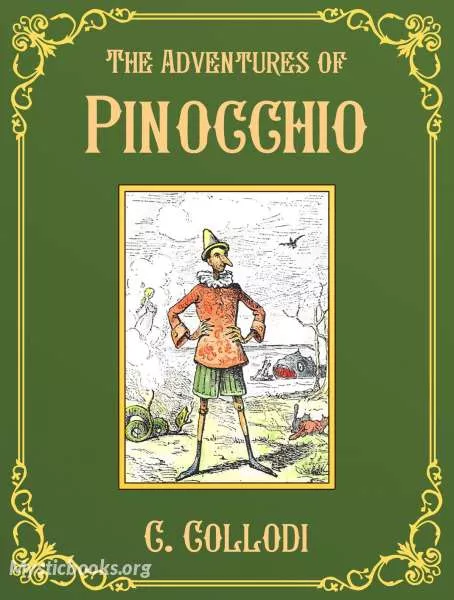Table of Contents
ToggleIntroduction
The Adventures Of Pinocchio Summary By Carlo Collodi The Adventures of Pinocchio is a classic Italian children’s novel written by Carlo Collodi, first published in 1883. Originally serialized in an Italian children’s magazine and later published as a book, the novel tells the story of Pinocchio, a wooden puppet carved by the poor woodworker Geppetto, who dreams of becoming a real boy. The story, filled with vivid characters, allegorical messages, and moral lessons, has been beloved by generations of readers worldwide. Over the years, it has been adapted into numerous stage plays, films, and cartoons, most notably the 1940 Disney animated film.
Collodi’s novel is not only a fantastical adventure but also an exploration of themes such as education, morality, and the consequences of one’s actions. The story is structured around Pinocchio’s journey toward self-awareness and personal growth. He faces numerous challenges, makes poor decisions, and is often swayed by temptation. Through these trials, the novel serves as a cautionary tale about the importance of responsibility, truth, and the consequences of dishonesty.
Summary of The Adventures of Pinocchio
The Creation of Pinocchio
The story begins with Geppetto, a kind but poor woodcarver, who creates a puppet from a magical piece of wood. This puppet, which he names Pinocchio, comes to life when Geppetto carves him, and the puppet begins to display human-like behaviors such as talking and moving. Pinocchio’s creation is miraculous, and Geppetto hopes that the puppet will one day be a real boy. However, Pinocchio’s adventure is not as simple as Geppetto might have hoped, as he must undergo many trials and tribulations before becoming a real boy.
Read more
Pinocchio’s Early Mischief
As a puppet, Pinocchio quickly shows his disobedient nature. He is stubborn, reckless, and enjoys playing pranks, but he is also easily influenced by those around him. One of his first major mistakes occurs when he meets a talking cricket, whom he dismisses when the cricket warns him of the consequences of misbehavior. Pinocchio’s stubbornness leads him to reject the advice of those who try to guide him.
After being brought to life, Pinocchio’s behavior takes him on a journey full of challenges, both physical and moral. One of the first incidents involves his decision to run away from home, escaping Geppetto’s loving care to follow what seems like a more exciting life in the world. He ends up in the company of unscrupulous individuals, such as the fox and the cat, who trick him into thinking that he can become rich by planting gold coins. This moment foreshadows a key theme in the novel—Pinocchio’s tendency to follow his desires without thinking of the consequences.
The Puppet’s Adventures and Lessons
Pinocchio’s life is filled with a series of misadventures. He is repeatedly deceived, captured, and punished for his actions. However, each setback provides a moral lesson. At one point, he is swallowed by a giant fish, where he is reunited with Geppetto, who has been searching for him tirelessly. Their reunion is heartwarming and symbolizes the strength of family love. Despite these moments of growth, Pinocchio continues to struggle with making wise decisions, often allowing his emotions to lead him astray.
As Pinocchio continues to grow, his actions and the lessons he learns from them become more important. He experiences the consequences of his lies, which cause his nose to grow, and realizes that his selfishness and dishonesty have lasting effects on those around him. These growing pains are crucial in Pinocchio’s development into a more self-aware and moral individual.

Pinocchio’s Transformation into a Real Boy
The climax of the story comes when Pinocchio finally learns that only by being honest, kind, and obedient will he be transformed into a real boy. After many mistakes and a deepening understanding of what it means to be a good person, Pinocchio proves himself worthy of this transformation. His final test comes when he rescues Geppetto, who has been swallowed by the fish. In doing so, Pinocchio shows great courage, selflessness, and maturity—qualities that mark his journey toward becoming a true boy. The Adventures Of Pinocchio Summary By Carlo Collodi
Ultimately, through Pinocchio’s transformation, Collodi offers a message about the power of change and the importance of personal growth. Pinocchio is not simply handed his transformation; he earns it through hard work, persistence, and learning from his mistakes. His journey reflects the idea that anyone, regardless of their background or flaws, can grow and change if they strive to do better.
Themes in The Adventures of Pinocchio
1. The Importance of Obedience and Responsibility
One of the central themes of the novel is the importance of obedience and responsibility. Pinocchio starts out as a disobedient and irresponsible puppet who refuses to listen to those who care about him, particularly Geppetto. His refusal to follow advice leads to a series of misadventures that teach him the importance of making wise choices and being responsible for his actions. Geppetto represents the ideal of a loving, responsible parent who guides and watches over Pinocchio, urging him to follow a moral path.
The novel underscores the idea that growth and development come from understanding the consequences of one’s actions. The transformation of Pinocchio into a real boy is symbolic of the rewards that come with becoming responsible and making the right choices. The Adventures Of Pinocchio Summary By Carlo Collodi
Read more
2. The Consequences of Lying and Dishonesty
Pinocchio’s growing nose, which lengthens whenever he lies, serves as a clear allegory for the consequences of dishonesty. Through this recurring motif, the novel sends a strong moral message about the importance of truthfulness. Pinocchio’s lies cause problems for himself and those around him, highlighting the disruptive nature of falsehoods.
Collodi’s message about lying extends beyond Pinocchio’s character to encompass societal values. The novel stresses that honesty is essential for personal integrity and social harmony. Pinocchio’s eventual transformation into a real boy is directly tied to his ability to accept truthfulness as a cornerstone of his character.
3. The Role of Education and Learning
Education plays a significant role in the development of Pinocchio. In the beginning, Pinocchio rejects education and formal learning, instead preferring a life of adventure and mischief. However, through his various experiences and encounters, he gradually learns valuable life lessons. Pinocchio’s education is not limited to books or school; rather, it is gained through life experiences, relationships, and the challenges he faces. The Adventures Of Pinocchio Summary By Carlo Collodi
The novel suggests that true education is not just about academic knowledge but about developing moral and emotional intelligence. Pinocchio learns lessons about love, kindness, and honesty through his actions and the consequences that follow.
4. The Value of Family and Sacrifice
The bond between Pinocchio and Geppetto is central to the novel’s emotional core. Geppetto’s love for Pinocchio is selfless and unconditional, and his willingness to sacrifice for Pinocchio’s well-being is evident throughout the story. The novel emphasizes the importance of family and the sacrifices that family members make for one another.
Pinocchio’s ultimate transformation into a real boy is deeply connected to his understanding of the sacrifices made by his father. The theme of parental love and sacrifice highlights the value of loyalty, care, and mutual respect within a family unit.
5. The Journey to Self-Awareness and Personal Growth
Pinocchio’s journey is not just about physical adventures but also about emotional and moral growth. He starts as a naive and selfish character, but through a series of mistakes and realizations, he gradually becomes a more thoughtful and self-aware individual. The novel’s structure—full of misadventures, moral lessons, and personal reflection—mirrors the process of growing up and learning to make better choices.
Pinocchio’s transformation into a real boy is symbolic of the broader human experience of maturation and the acquisition of wisdom. The novel underscores that growth comes from learning from one’s mistakes and evolving through experience. The Adventures Of Pinocchio Summary By Carlo Collodi

Conclusion
The Adventures of Pinocchio remains one of the most beloved and enduring works of children’s literature. Through the adventures of its protagonist, Carlo Collodi explores deep themes of morality, education, family, and personal growth. Pinocchio’s journey from mischief to maturity is a timeless tale that resonates with readers of all ages, offering valuable lessons about life, honesty, and the importance of learning from one’s mistakes. The Adventures Of Pinocchio Summary By Carlo Collodi
With its rich characters, captivating plot, and profound moral messages, The Adventures of Pinocchio continues to be an essential part of the literary canon, cherished by readers and adapted into various media worldwide. The Adventures Of Pinocchio Summary By Carlo Collodi
Read more
1. What is the plot of The Adventures of Pinocchio?
The Adventures of Pinocchio follows the story of a wooden puppet named Pinocchio, who is carved by the poor woodworker Geppetto. After coming to life, Pinocchio embarks on a series of adventures, making poor decisions and learning valuable life lessons. Through his misadventures, Pinocchio gradually learns the importance of honesty, responsibility, and family, and ultimately transforms into a real boy after proving his growth and maturity.
2. What are the major themes of the novel?
The major themes of The Adventures of Pinocchio include the importance of obedience and responsibility, the consequences of lying and dishonesty, the role of education and learning, the value of family and sacrifice, and the journey to self-awareness and personal growth. The novel emphasizes that growth and transformation come through making wise choices and learning from mistakes. The Adventures Of Pinocchio Summary By Carlo Collodi
3. What is Pinocchio’s transformation in the novel?
Pinocchio’s transformation in the novel is from a wooden puppet into a real boy. This transformation symbolizes his moral and emotional growth as he learns valuable lessons about honesty, responsibility, and the importance of family. The transformation reflects the idea that personal growth and the ability to make responsible choices are essential for maturity.
4. Who is the antagonist in The Adventures of Pinocchio?
While The Adventures of Pinocchio does not feature a single antagonist, several characters and forces serve as obstacles to Pinocchio’s growth. These include characters like the fox and the cat, who deceive him, and his own impulsive behavior and tendency to make poor decisions. The main antagonist, in a sense, is Pinocchio’s own immaturity, which he must overcome to become a real boy.
5. Why is Pinocchio’s nose important in the story?
Pinocchio’s nose is a symbolic feature that grows longer every time he lies. This physical transformation serves as an allegory for the consequences of dishonesty. It highlights the moral message of the novel: that lying leads to problems and negative consequences, while honesty is the key to personal integrity and social harmony. The Adventures Of Pinocchio Summary By Carlo Collodi
6. What lessons can be learned from The Adventures of Pinocchio?
The Adventures of Pinocchio teaches several important lessons, including the value of honesty, the importance of responsibility, and the significance of self-awareness and personal growth. The novel emphasizes that individuals must learn from their mistakes and make wise choices in order to achieve fulfillment and personal transformation.

















